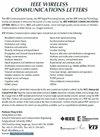一种基于虚拟散射映射的高效海量MIMO信道重构方法
IF 5.5
3区 计算机科学
Q1 COMPUTER SCIENCE, INFORMATION SYSTEMS
引用次数: 0
摘要
在这篇文章中,我们引入了一个名为虚拟散射体映射(VSM)的新概念,以减少大规模MIMO信道重建的导频开销和计算复杂度。VSM存储主要虚拟散射体的位置,用户可以在散布在单元上的一些预定的用户网格点上看到这些虚拟散射体。VSM可以通过离线测量或射线追踪模拟来构建。基于VSM,我们提出了一种有效的信道重建方法,减少了导频开销和计算复杂度。具体而言,针对目标用户,通过对VSM中邻近用户网格点的虚拟散射体(散射环境的先验信息)进行聚类和加权估计,然后提出一种svm辅助turbo变分贝叶斯推断(turbo - vbi)算法,将VSM提供的先验信息与少数上行导频观测结果有效融合,实现低开销、低复杂度、高精度的信道重建。此外,VSM辅助的Turbo-VBI算法可以自动检测VSM遗漏的路径(虚拟散射体)。仿真结果表明,该方法能有效降低导频开销。本文章由计算机程序翻译,如有差异,请以英文原文为准。
An Efficient Massive MIMO Channel Reconstruction Method Based on Virtual Scatterer Map
In this letter, we introduce a novel concept called the virtual scatterer map (VSM) to reduce both the pilot overhead and computational complexity of massive MIMO channel reconstruction. The VSM stores the locations of the dominant virtual scatterers that can be seen by users at some predetermined user grid points spread over the cell. The VSM can be constructed by offline measurements or ray tracing simulation. Based on the VSM, we propose an efficient channel reconstruction method with reduced pilot overhead and computational complexity. Specifically, for a target user, the virtual scatterers (prior information about the scattering environment) are estimated by clustering and weighting those from neighboring user grid points in the VSM, and then a VSM-assisted turbo variational Bayesian inference (Turbo-VBI) algorithm is proposed to efficiently fuse the prior information provided by the VSM and the observations from a few uplink pilots to achieve low-overhead, low-complexity, and high-accuracy channel reconstruction. In addition, the paths (virtual scatterers) missed by the VSM can be automatically detected by the VSM-assisted Turbo-VBI algorithm. Simulation results show that our proposed method can effectively reduce the pilot overhead.
求助全文
通过发布文献求助,成功后即可免费获取论文全文。
去求助
来源期刊

IEEE Wireless Communications Letters
Engineering-Electrical and Electronic Engineering
CiteScore
12.30
自引率
6.30%
发文量
481
期刊介绍:
IEEE Wireless Communications Letters publishes short papers in a rapid publication cycle on advances in the state-of-the-art of wireless communications. Both theoretical contributions (including new techniques, concepts, and analyses) and practical contributions (including system experiments and prototypes, and new applications) are encouraged. This journal focuses on the physical layer and the link layer of wireless communication systems.
 求助内容:
求助内容: 应助结果提醒方式:
应助结果提醒方式:


